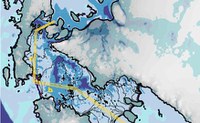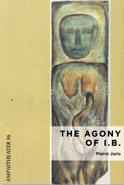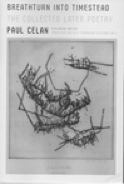West Antarctica’s ice masses
Press Release by the Potsdam Institute for Climate Impact Research (PIK)
11/02/2015
 Local destabilization can cause complete loss of West Antarctica’s ice masses
Local destabilization can cause complete loss of West Antarctica’s ice masses
The huge West Antarctic ice sheet would collapse completely if the comparatively small Amundsen Basin is destabilized, scientists of the Potsdam Institute for Climate Impact Research find. A full discharge of ice into the ocean is calculated to yield about 3 meters of sea-level rise. Recent studies indicated that this area of the ice continent is already losing stability, making it the first element in the climate system about to tip. The new publication for the first time shows the inevitable consequence of such an event. According to the computer simulations, a few decades of ocean warming can start an ice loss that continues for centuries or even millennia.
“What we call the eternal ice of Antarctica unfortunately turns out not to be eternal at all,” says Johannes Feldmann, lead author of the study to be published in the Proceedings of the National Academy of Sciences (PNAS). “Once the ice masses get perturbed, which is what is happening today, they respond in a non-linear way: there is a relatively sudden breakdown of stability after a long period during which little change can be found.”
“A few decades can kickstart change going on for millennia”
This is what is expressed by the concept of tipping elements: pushed too far, they fall over into another state. This also applies to, for instance, the Amazon rainforest, and the Indian Monsoon system. In parts of Antarctica, the natural ice-flow into the ocean would substantially and permanently increase.
Ocean warming is slowly melting the ice shelves from beneath, those floating extensions of the land ice. Large portions of the West Antarctic ice sheet are grounded on bedrock below sea level and generally slope downwards in an inland direction. Ice loss can make the grounding line retreat, thereby exposing more and more ice to the slightly warmer ocean water – further accelerating the retreat.
“In our simulations 60 years of melting at the presently observed rate are enough to launch a process which is then unstoppable and goes on for thousands of years,” Feldmann says. This would eventually yield at least 3 meters of sea-level rise. “This certainly is a long process,” Feldmann says. “But it’s likely starting right now.”
The greenhouse-gas emission factor
“So far we lack sufficient evidence to tell whether or not the Amundsen ice destabilization is due to greenhouse gases and the resulting global warming,” says co-author and IPCC sea-level expert Anders Levermann, also from the Potsdam Institute. “But it is clear that further greenhouse-gas emission will heighten the risk of an ice collapse in West Antarctica and more unstoppable sea-level rise.”
“That is not something we have to be afraid of, because it develops slowly,” concludes Levermann. “But it might be something to worry about, because it would destroy our future heritage by consuming the cities we live in – unless we reduce carbon emission quickly.”
Article: Feldmann, J., Levermann, A. (2015): Collapse of the West Antarctic Ice Sheet after local destabilization of the Amundsen Basin. Proceedings of the National Academy of Sciences (PNAS, Online Early Edition) [DOI: 10.1073/pnas.1512482112]
Weblink to the article once it is published:
www.pnas.org/cgi/doi/10.1073/pnas.1512482112
For further information please contact:
PIK press office
Phone: +49 331 288 25 07
E-Mail: press@pik-potsdam.de
Twitter: @PIK_Climate

 Poasis II: Selected Poems 2000-2024
Poasis II: Selected Poems 2000-2024 “Todesguge/Deathfugue”
“Todesguge/Deathfugue” “Interglacial Narrows (Poems 1915-2021)”
“Interglacial Narrows (Poems 1915-2021)” “Always the Many, Never the One: Conversations In-between, with Florent Toniello”
“Always the Many, Never the One: Conversations In-between, with Florent Toniello” “Conversations in the Pyrenees”
“Conversations in the Pyrenees” “A Voice Full of Cities: The Collected Essays of Robert Kelly.” Edited by Pierre Joris & Peter Cockelbergh
“A Voice Full of Cities: The Collected Essays of Robert Kelly.” Edited by Pierre Joris & Peter Cockelbergh “An American Suite” (Poems) —Inpatient Press
“An American Suite” (Poems) —Inpatient Press “Arabia (not so) Deserta” : Essays on Maghrebi & Mashreqi Writing & Culture
“Arabia (not so) Deserta” : Essays on Maghrebi & Mashreqi Writing & Culture “Barzakh” (Poems 2000-2012)
“Barzakh” (Poems 2000-2012) “Fox-trails, -tales & -trots”
“Fox-trails, -tales & -trots” “The Agony of I.B.” — A play. Editions PHI & TNL 2016
“The Agony of I.B.” — A play. Editions PHI & TNL 2016 “The Book of U / Le livre des cormorans”
“The Book of U / Le livre des cormorans” “Memory Rose Into Threshold Speech: The Collected Earlier Poetry of Paul Celan”
“Memory Rose Into Threshold Speech: The Collected Earlier Poetry of Paul Celan” “Paul Celan, Microliths They Are, Little Stones”
“Paul Celan, Microliths They Are, Little Stones” “Paul Celan: Breathturn into Timestead-The Collected Later Poetry.” Translated & with commentary by Pierre Joris. Farrar, Straus & Giroux
“Paul Celan: Breathturn into Timestead-The Collected Later Poetry.” Translated & with commentary by Pierre Joris. Farrar, Straus & Giroux
Happy to see that Potsdam is still cranking out their error prone computer models based on every “if” they can think of. Wasn’t Manhattan supposed to be under water by now? That will happen in any case when the perfect hurricane hits the mouth of the overly narrowed Hudson River. Ask the Army Corps of Engineers.
The U.N., the Pope and a vast array of over the wall Climate Alarmists are 3 reasons why I remain a skeptic. Skepticism is after all the essence of true science. The scientific method is founded on rational skepticism, not the unthinking acceptance of some orthodoxy, opinion or perceived wisdom.
The gap between critical thinkers and those of strictly ideological positions grows ever wider. Me, I like the critical thinkers. When a critical thinker disagrees with you, they simply think you’re wrong. And say so. When an ideologue disagrees with you, they rant, rave and call you names. They think you are evil. And say so.
Potsdam offers a fine example of how discussions about climate change are now solely between ideologues. They agree with each other. It is less a science and more a club of self-proclaimed “environmentalists” who want to shut down all debate. Theirs is the “correct” position. No further thought is necessary.
Dr. Klaus L. E. Kaiser has been swatting Potsdam like a ‘one-winged fly’ for years. First, a little background. The author of ‘Convenient Myths, the green revolution – perceptions, politics, and facts’, Dr. Kaiser, scientist and author, has been conducting research for more than four decades. He received his Phd. At the Technical University Munich. He works for Environment Canada’s National Water Research Institute. He served as research scientist and project manager for several research groups. He represented the institute at a variety of national and international committees. He gave numerous presentations at scientific conferences, was editorial board member and peer reviewer for several journals, adjunct professor and external reviewer of university theses, and was the Editor-in- Chief of the Water Quality Research Journal of Canada for nearly ten years. He is the author of nearly 300 publications in scientific journals, government and national and international agency reports, books, trade magazines, and newspapers. He has been president of the Intl. Association for Great Lakes Research and is a recipient of the Intl. QSAR Award. He is currently Director of Research of TerraBase Inc., and is a Fellow of the Chemical Institute of Canada. In short, he knows his stuff.
As of his 9/30/15 report on the Arctic:“The sea-ice extent is actually quite stable, perhaps even growing and the polar bears are just fine as well.” He concedes that these facts are “disconcerting to the warmists.”
He cites Prof. S. Rahmstorf at the Potsdam Institute for Climate Impact Research (PIK) as one of the “doom-and-gloom artists” that “have been quite vociferous in predicting an “ice-free Arctic” (in summer) for years now.” He further notes that Prof. S Rahmstorf, “one of Germany’s most outspoken climate modellers, repeatedly warned the world of that coming (or already triggered) “tipping point” calamity, in 2008 and again in 2012.” We’re still waiting.
To call someone a “climate change denier” has become a smear tantamount to a “Holocaust Denier.” The eco-warriors have decided just who can and who cannot discuss the issue without being branded. In essence, these so-called “experts” have attacked free speech and, naturally, missed the point entirely. A climate or environmental debate at its heart is an economic one. That is why they keep asking for more and more money. Whether it be through grants, a carbon tax or cap-and-trade (another name for a less efficient carbon tax far more open to political corruption), the end game is the same, a transfer of wealth and a massive build-up of bureaucracy.
His work is available so I’ll just sign off with a few rather pithy facts from Dr. Kaiser.
“The sea-ice in the Arctic waxes and wanes in a regular fashion, sort of like the phases of the Moon.”
“For example, the number of days with air temperature above freezing (0 C) at latitude 80 N and higher have been recorded for 55 years now. These data are readily available from the Danish Meteorological Institute (DMI). On the basis of such observations, they have also calculated a 50-year mean of temperatures above freezing. It has not changed in that time and you can follow it daily as well as all daily records over the past, year by year.”
“These data not only show a very stable climate up north, they also indicate that the claims of a “thinning” ice-cover must be false. You cannot possibly have the ice thinning and the air warming and the ice-cover being unaffected decade after decade. If the ice were getting thinner, it would melt earlier, the number of days above freezing would increase and the re-freezing would happen later in the season; none of which is happening.”
“To begin with, hardly a soul ever mentions the MAXIMUM seasonal sea-ice extent in the Arctic. In truth, it hasn’t changed much for many decades. The reasons are easy to understand. With most of the year being well below freezing, the annual ice build-up is affected more by wind and currents than anything else. Therefore, it reaches a maximum at around mid-March that barely varies between years. In that context, it should also be noted that, by most accounts, the “Arctic” sea-ice count extends south to latitude 45 N, or even further towards the equator. Still, the maximum ice extent barely changes, so, no need to mention it further.”
“Also, there are few visitors to the high Arctic in winter. Not only is it dark for many days then, the temperatures aren’t exactly suited for frolicking either. At MINUS 40 C, even the (male) polar bears that are not hibernating are beginning to shiver. In my humble opinion, it’s a pity that the many famous climate modellers from PIK and other institutions don’t want to visit then. The local government may even provide free accommodation then (with a minimum stay of four-weeks) in tents or igloos, visitors’ choice. What could be more relaxing than a few weeks in an igloo when a blizzard rages on the outside? If need be, they can bring along a portable windmill to charge their i-thing or laptop.”
“There are the widely used daily satellite surveys of Arctic sea-ice published by the Nansen Environmental & Remote Sensing Center at Bergen, Norway. These satellite observations have changed repeatedly in terms of instrumentation and computer algorithms used. Therefore earlier measurement series (i.e. before 2000 or so) are not fully compatible with later ones.”
“Another widely used series of measurements is that of sea-ice in the northern hemisphere by the National Snow & Ice Data Center at Boulder, CO. In addition, the DMI also provides daily graphs on the Arctic sea-ice extent. As the graphs produced by each institute have their own spatial resolution and/or definition of what constitutes “sea-ice” versus water, they give different absolute numbers; by and large though the graphs show similar trends.”
“There is one ice measurement that has yet to see widespread use, namely the annual sea-ice average as computed from all daily data (from one source). Such an analysis is available from the Science Matters website. It has just published that for the last ten years. That graph actually shows a slightly increasing trend of the Arctic ice extent in that period.”
“In short, no matter what measurement you use to look at ice in the North, it shows no sign of going the way of the dodo bird, rather the opposite. The doomsayers’ claims about the ice disappearing are false—and you’ll still need your winter woollies!”
He is worth a read.
I get so carried away with the Arctic as it is our northern coast (sea to sea to sea) that I neglected to mention a recent NASA study (September 30th, I believe) that stated quite clearly Antarctica is gaining more ice than it has lost.
At the risk of irritating Poo (I sometimes wonder if Pierre posts these just to wind you up!):
http://www.theguardian.com/environment/2015/nov/12/collapsing-greenland-glacier-could-raise-sea-levels-by-half-a-metre-say-scientists
I apologize if I sound wound up. My heart rate and blood pressure remain unchanged and I get checked often enough to know. They are just opinions after all and I am old enough to still believe that there is no right or wrong in expressing them. I do realize that such a thought would have me hounded off a modern university campus. P. would never post just to rile me up. He thinks I am a reactionary old fart. He has known me for over 50 years and swears I have not changed other than once having been a young fart.
You’re probably right about being hounded, Poo(h).
You sound much younger!
Keep well,
K.